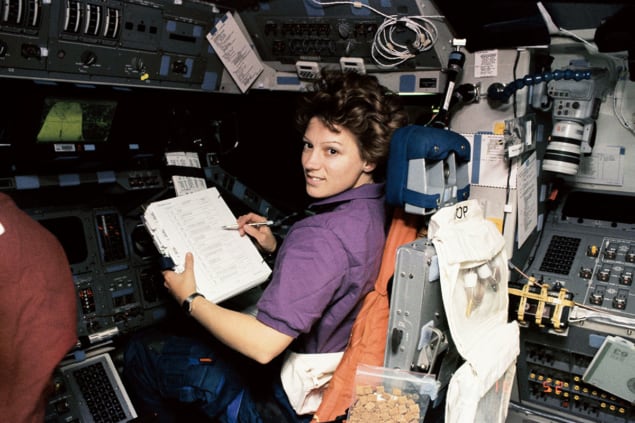Andrew Glester reviews Through the Glass Ceiling to the Stars: the Story of the First American Woman to Command a Space Mission by Eileen M Collins with Jonathan H Ward

Eileen Collins was the first woman to pilot, and later command, NASA’s Space Shuttle. She logged over 38 days in space and, as the commander of mission STS-93 in 1999, her legacy includes deploying the Chandra X-Ray Space Observatory. The story told in Collins’ autobiography Through the Glass Ceiling to the Stars is one of triumph over adversity, one that can inspire and excite the reader – but there is also a poignancy to reading it at this point in history.
Collins’ debut piloting the Space Shuttle in 1995 was also NASA’s first mission to approach and fly around the Russian space station, Mir (without docking). When Discovery was at the point of closest approach, Shuttle commander Jim Wetherbee said to Mir commander Aleksandr Viktorenko “Together we will lead our world into the next millennium,” to which the Russian cosmonaut responded “We are one. We are human.”
The Shuttle–Mir programme marked the beginning of a period of international collaboration in space, which, for many, reached its zenith with the International Space Station. In Collins’ book, we read stories of the fun that NASA and Roscosmos astronauts had while working together, even as politicians tangled with each other across borders on Earth. It is all a stark contrast to Vladimir Putin’s internationally condemned invasion of Ukraine – a tragedy that is now threatening even this most cherished of international partnerships.
Anyone looking for a spot of escapism to a time of collaboration, or an inspirational read, will find both among the pages of this book. The preface is a compelling description of Collins leaving Earth for the first time on board Discovery as part of that 1995 STS-63 mission. Such is the skill with which we are transported into the shuttle as it escapes the clutches of Earth’s gravity that readers could be forgiven for thinking they’d opened the latest Andy Weir novel. We leave the crew just as the curvature of the Earth comes into view through Discovery’s windows, and re-join them in a later chapter, but first we discover how you get to be the first woman to pilot a NASA Space Shuttle.
It might be tempting to think of astronauts as starting from some position of privilege, but it becomes clear that Collins has succeeded in the face of adversity. Her father was “the worst kind” of alcoholic, which had serious consequences for the whole family. Her mother became suicidal and was institutionalized, leaving Collins to run the home for herself and her two younger siblings.
Collins had a number of jobs to pay her way through an associate degree in maths and science at Corning Community College, including working the counter at a pizza restaurant and selling tickets at a pitch-and-putt golf course. From there her journey to space follows a familiar route to anyone who has read astronaut autobiographies – after training as a pilot she then worked as a pilot trainer before becoming a flight test pilot. While it’s no longer the only way to becoming an astronaut, as it was in the time of the Apollo missions, it is still a tried and tested route followed even by the likes of Tim Peake.
Once the “dream comes true”, the book examines each of Collins’ four journeys to space. As well as her inaugural mission in 1995, Collins piloted STS-84 in 1997, during which the Discovery crew boarded the Mir space station – the sixth such docking. But it was the 1999 mission, STS-93, that saw Collins become the first woman to command the Space Shuttle. The primary objective of this mission was to deploy the Chandra X-Ray Observatory, which still provides data today, having led, for example, to the discovery in March 2021 that Uranus emits X-rays.
Next follows a deeply affecting chapter retelling the tragedy of Columbia, the Space Shuttle that disintegrated upon re-entry in 2003, from the perspective of those in the programme. Collins’ fourth and final trip, STS-114 in 2005, was NASA’s first “return to flight” mission after the accident. To read of the emotional resolve of the astronauts at the centre of that historic time is one of the most compelling segments of the book.
Collins’ determination and strength of character shines throughout this book, with the title pointing to the misogyny that Collins, like so many women, had to confront and, at times, rise above. There is no sense of complaint in the pages, but the reader will become aware of a series of microaggressions that confronted Collins in her rise to the peak of her profession.
I like to believe that my story shows that people who play by the rules and act with character and integrity can indeed finish first
Eileen Collins
There is a common misconception that to get to the top, one must “tread on a few toes” or burn a few bridges. Towards the end of the book, Collins reflects, “I like to believe that my story shows that people who play by the rules and act with character and integrity can indeed finish first.” It is just one lesson to take from a book that I would recommend to anyone with the slightest interest in human space flight, or who is striving to be the best person they can be in any walk of life.
- 2022 Simon & Schuster £20hb



